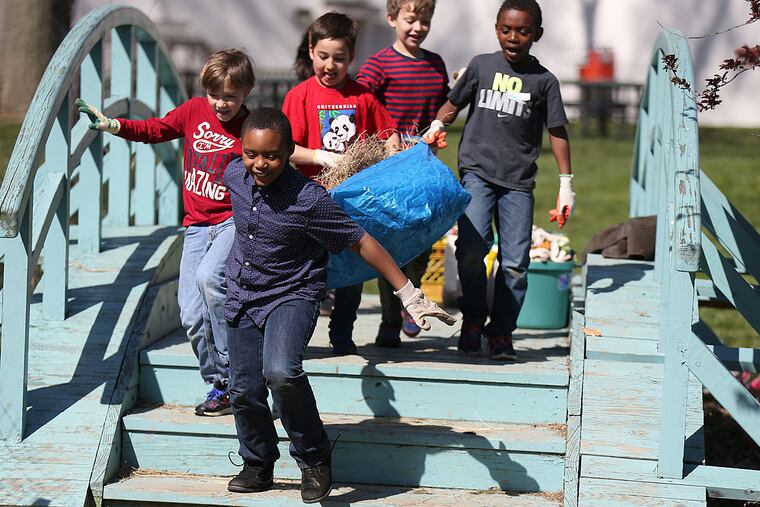Every day is Earth Day along Jenkintown Creek
Rosanne Mistretta has taught environmental science for 16 years on Abington Friends School's 50-acre campus, using its branch of Jenkintown Creek and its 300 towering trees as a kid-magnet green classroom.

Rosanne Mistretta has taught environmental science for 16 years on Abington Friends School's 50-acre campus, using its branch of Jenkintown Creek and its 300 towering trees as a kid-magnet green classroom.
So, she was overwhelmed with joy when Julie Slavet, executive director of the Tookany Tacony-Frankford Watershed Partnership, told Abington Friends staffers in 2014 that $105,547 was available to plant a riparian buffer of 350 saplings along the creek and create a rain garden at its headwaters behind the lower school.
"We're in this big meeting, we're talking riparian buffers, and everybody's getting excited," Mistretta said. "And then somebody asked, 'What's a riparian buffer?' "
Slavet explained that it's an area of vegetation along the banks that prevents erosion and filters storm water pollutants.
"This was like a gift from the gods," Mistretta said. "This was a dream that I and a lot of teachers here had for a long time, but that stuff takes money. So we were, like, 'OK, just tell us what to do. We'll do anything you want.' "
Like the streams feeding Jenkintown Creek, money for the project flowed from funders including the William Penn Foundation into the nonprofit TTF Watershed Partnership, guardian of a 33-square-mile basin from Montgomery County to the Betsy Ross Bridge on the Delaware. True to Mistretta's vow to "do anything," Abington Friends students, staff, and community members supplied sweat equity, planting the buffer and rain garden.
Now, every day is Earth Day at Abington Friends, where 538 students in grades pre-K through 12 maintain the 350 creek-side saplings - native red and white oaks, birch, magnolia, dogwood. They tend the 2,000-square-foot rain garden - a mix of the grassy sedges and sea oats that stabilize sand dunes, native trees such as serviceberry, hackberry, and redbud, and a rainbow of wildflowers - that manages storm water runoff from 17,000 square feet of parking lot.
The campus goes even greener on April 30 with the school's Ecofest, a public celebration of nature that will inaugurate a mile-long public arboretum. Visitors can take self-guided tours with their smartphones along a path through the schools' mature trees, which are labeled and pinpointed on an online map.
Another eco-opening is set for mid-May. The school's self-funded $620,000 Headwaters Discovery Playground, for students only, will have a sluice gate, pulleys, levers, stumps, logs, and a huge, multilevel tree house. Metcalfe Architecture & Design of Philadelphia created the playground with the same oomph it put into the "Out on a Limb" Tree Canopy Walk 50 feet above the forest floor at Morris Arboretum.
"We're not building a pirate ship," Mistretta quipped.
Passing the playground, she came upon fingerlike tree roots reaching down the banks of Jenkintown Creek, and below that, clear waters running over a swaying carpet of emerald-green algae.
"My whole third-grade curriculum was based on the creek walk," Mistretta said. "We did water testing at the creek, drawings, writing observational notes. Every student on this campus is very familiar with the creek."
Mistretta has been a creek person since her childhood in Pittston, a coal-mining town by the Susquehanna River in Luzerne County. She went to Girl Scout Camp Louise in nearby Berwick "all summer, every summer," she recalled, and "every moment of every day that I could spend outdoors, I did."
"Taking a hike down the middle of a stream was one of my favorite things to do. Getting totally wet and dirty and muddy and just kind of splashing."
During her teen years as a Camp Louise counselor, she found her environmentalist soul.
"We'd take five-day canoe trips on the Susquehanna," she said. "You would see areas that were really clean and beautiful, and then you would pass, like, a factory and the water would change and we would tell the kids not to get out of the canoes."
In the 1980s and '90s, Mistretta was a lawyer for the Environmental Protection Agency, working on major pollution cases including the illegal dumping of thousands of gallons of waste oil into Pittston's Butler Mine Tunnel shafts.
"During Hurricane Gloria in 1985," she said, "the water rose, and all of that stuff came pouring out of the mine into the Susquehanna River," creating an oil slick 35 miles long.
After 10 years of EPA Superfund cases, Mistretta left law for Abington Friends in 2000. But this, she said, is her finest environmental teaching year.
The TTF Watershed Partnership not only channeled foundation money to Abington Friends, but a little further downstream, as well, to the property of St. Basil the Great convent and Manor College. There, the nuns helped Manor students plant a second rain garden.
Replacing compacted clay soil with compost, sand, and topsoil and planting native grasses with deep roots has helped prevent runoff from the 13,500-square-foot college parking lot. Before, it poured into Jenkintown Creek, which eventually feeds into the Tookany Creek.
All these projects are grounded in a common need. That is, Mistretta said, "to teach kids to love the Earth before they can protect it."
610-313-8109